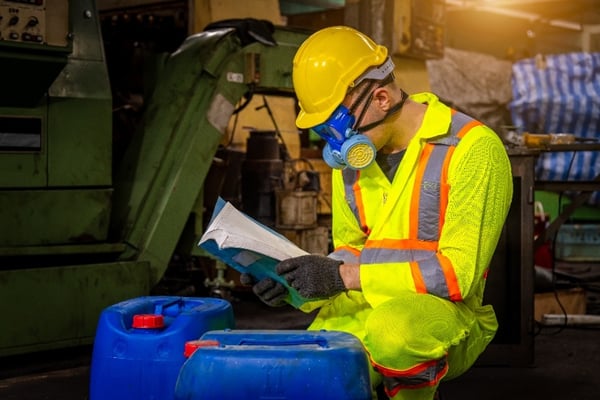What is Inhalation?
Inhalation is the process by which other gases or air enter your lungs. Inhalation is a vital process in breathing that is critical for sustaining life. Inhalation occurs autonomically and doesn’t require any control.
But, while this is a biological process, inhalation is a serious process that occurs when chemicals are inhaled in the body. These chemicals are absorbed within the body via the lungs, and are then passed into the bloodstream.
Inhaling harmful gases results in a serious risk and can cause serious illnesses or injuries. Companies need to take appropriate steps to ensure that employees take steps to prevent injuries or illnesses caused by inhaling harmful gases.
Reduce Workplace Incidents by Managing Chemical Risk
Empower your team to handle chemicals with confidence. Download Your FREE Guide to Effective Chemical Risk Management!
 Are your workers safely protecting themselves against dangerous substances while in work?
Are your workers safely protecting themselves against dangerous substances while in work?
Why is it Important to Prevent Inhalation of Harmful Gases?
Respiratory personal protection in the workplace is very important for employees that work in industries where they’re exposed to harmful gases or chemicals. A respirator is a simple protective device that prevents harmful exposure to airborne hazards.
Harmful particles in the air often include:
- Dust
- Mists
- Smoke
- Vapors
- Gases that when inhaled may result in injury, illness, disease or loss of function
Airborne contaminants can result in serious injury, and it’s important for companies to identify all major respiratory hazards. This requires organizations to also evaluate allowable exposure levels by reviewing the Safety Data Sheets for each material that employees are exposed to.
Certain employees, especially those that perform physical labour, tend to breathe harder, inhaling more than 6 litres of air within a minute. Chemicals that enter the bloodstream through the lungs can spread quickly throughout the body and may result in a serious illness.
How Are Different Chemicals Inhaled?
Here are some different ways by which harmful chemicals can enter the body.
Vapours and Gases
Evaporation is arguably the most common way by which gases tend to enter the body. Certain organic solvents, including alcohols or toluene evaporate much faster than conventional liquids like water or certain acids.
When gases evaporate, they release vapours, which can be inhaled quite easily unless employees are wearing respiratory protection. Vapours can contaminate the air in the workplace. More importantly, certain harmful gases that are odourless can also result in injury or illness.
These gases are released due to chemical processes or because of a leakage. If a leakage isn’t identified in time, it could result in serious medical effects.
Harmful Mists
Certain industrial processes may result in the release of harmful mists, which are simply droplets that are so light that they float in the air. Mists are generally gases that condense into liquids. For instance, oil mists are generally released due to grinding and cutting.
Harmful mists can be inhaled through the nose if employees aren’t using any respiratory protection.
Smoke, Fumes, and Dusts
Certain workplace processes may cause the release of very small solid particles. They are not dense at all, thus allowing them to float in the air. Fine dust is a prime example.
Often released due to mechanical activity, dusts can be inhaled and may result in a serious lung infection. Fumes, on the other hand, tend to remain airborne for longer periods.
Fumes are created when heated metals evaporate in the air and then condense into their solid state. A common example is the fumes that are generated due to welding.
And finally, there’s smoke, which is released due to the burning process. Essentially, smoke is just soot or carbon that’s released in the air.
How to Mitigate the Risks of Harmful Inhalation
Companies need to take steps to mitigate the risks of harmful inhalation to ensure employee safety. Once the company has identified sources of harmful airborne particles, they can take different steps, as discussed below.
Implement Engineering Control Measures
One of the most effective ways to mitigate the risks caused by harmful inhalation is to enclose or isolate processes that result in the release of such gases. Companies can look at exhaust ventilation solutions or identify methods to dilute the gases in the air.
Implement Administrative Controls
Another option is to implement appropriate administrative controls. Companies can take different steps to limit exposure, such as adjusting work schedules or establishing best practices to minimize risk. This is ideal when engineering controls are not enough to reduce hazards.
Safety Training and Awareness
It’s also important for companies to offer appropriate safety training and to spread awareness about respiratory hazards. This plays a critical role as it helps employees better understand the harmful nature of the chemicals that they work with.
Using Face Masks and Respirators
It’s understandable that controls might not be enough in certain situations. When that happens, it’s imperative for companies to provide personal protective equipment to employees. This includes face masks and respirators that offer adequate protection.
In some cases, respirators might be used voluntarily, but depending on the severity of the risk, companies may mandate the usage of face masks and respirators to minimize risk.
Depending upon the level of risk, the company can opt for face masks or respirators with varying levels of particulate filters too.
Reduce Workplace Incidents by Managing Chemical Risk
Empower your team to handle chemicals with confidence. Download Your FREE Guide to Effective Chemical Risk Management!
Use EcoOnline’s Health & Safety Software to Identify and Record Safety Hazards
EcoOnline’s Health & Safety Software is an excellent choice for companies that want to identify and record safety hazards in the workplace. The cloud-based solution allows companies to identify major hazards and provide information to employees on how to protect themselves.

